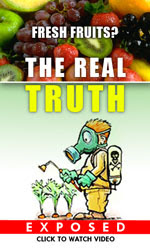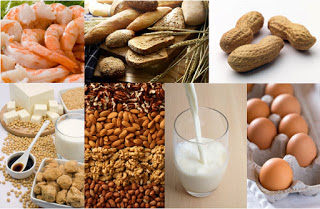Food Allergies: What’s To Eat? Part 1
How many people have food allergies? According to FARE, Food Allergy Research & Education, estimates run as high as 15 million Americans with one in 13 U.S. children under the age of 18 affected by food allergies, which can be life threatening and deadly.[1] Food allergies can be extremely serious when people don’t understand the ramifications of what can happen when an individual is exposed to foods they are allergic to.
Recently I read about a young man who suffered bullying in school because of his peanut allergies when an unenlightened student rubbed peanut butter cracker dust into his hair. Can you imagine how frightening that experience was for the allergic young man and how serious the outcome could have been? What we don’t know about food allergies can harm not only us but others with whom we interact on a daily basis, especially children.
In a school where I taught writing courses, there was a “Peanut Free Room” that was identified on both doors with warning signs. Most people are aware of asthma and chemical triggers that can provoke an asthma attack. However, not everyone knows about various food allergies and where offending food items can be found, either openly or hidden as processing ingredients.
Widget not in any sidebars
For those individuals who have severe food allergies, I empathize with them. In my former practice as a natural nutritionist—I’m retired now—I saw many children who were nutritionally compromised and deficient because of food allergies. Also, parents—mothers, in particular—who were at their wits ends as to how to feed their allergic children. My usual course of nutritional counseling was to start the child on a mono diet, i.e., only one food at a time at a meal, especially if they had not had allergy testing. That was back in the 1980s when food allergies and testing were not in vogue, as they are today. Parents quickly realized which foods were problematic. I encouraged them to keep a food journal and a log for reactions of how soon reactions occurred. That was an extremely effective way to get a handle on offending foods. Even with today’s sophisticated allergy protocols, I think that methodology could be helpful in stabilizing or establishing safe eating patterns.
 So what are the most offending food allergies? From my training and professional experience, no food is exempt, as it depends upon an individual’s immune system, gut ecology and flora, plus emotional state. All three contribute to food allergies, together with genetic proclivities and any ‘specific body chemistry problem’ the individual may have. That being said, the easiest way to stabilize an allergic reaction is to remove the offending allergen and neutralize the situation as effectively and safely as possible—some may need emergency room care, or when stung by a bee or wasp, an immediate injection from an EpiPen® containing epinephrine. Care must be exercised, as not all persons can safely receive a shot of epinephrine. Please consider studying the information here regarding severe allergic reactions known as anaphylaxis.
So what are the most offending food allergies? From my training and professional experience, no food is exempt, as it depends upon an individual’s immune system, gut ecology and flora, plus emotional state. All three contribute to food allergies, together with genetic proclivities and any ‘specific body chemistry problem’ the individual may have. That being said, the easiest way to stabilize an allergic reaction is to remove the offending allergen and neutralize the situation as effectively and safely as possible—some may need emergency room care, or when stung by a bee or wasp, an immediate injection from an EpiPen® containing epinephrine. Care must be exercised, as not all persons can safely receive a shot of epinephrine. Please consider studying the information here regarding severe allergic reactions known as anaphylaxis.
The most common food allergies today, according to the Mayo Clinic,[2] are:
- Milk, eggs, peanuts
- Tree nuts (almonds, cashews, walnuts)
- Fish (bass, cod, flounder), shellfish (crab, lobster, shrimp)
- Soy and wheat.
However, another classification of allergy-type food is emerging and getting recognized for adverse effects on the human intestinal tract and gut. Those foods are genetically modified organisms known as GMOs or GEs. There is scientific research indicating intestinal damage from GMO food and the article “Glyphosate’s Suppression of Cytochrome P450 Enzymes and Amino Acid Biosynthesis by the Gut Microbiome: Pathways to Modern Disease”[3] discusses how the inordinate amount of pesticides sprayed on GMOs leaves residues in GMO crops that, in turn, are being traced to modern diseases.
In addition to transgenic and cisgenic modifications, which I encourage you to learn about here http://www.wisegeek.com/what-are-genetically-modified-organisms.htm#didyouknowout, GMO crops are sprayed with much more glyphosate herbicide[4] because they were genetically modified not to die from being sprayed with it. Farmers don’t have to “weed” their crops and weeds die automatically from all the spraying.
 One of the bumper GMO crops in the USA is corn, also known as bt-corn because of the Bacillus thurigiensis that is ‘spliced’ into corn seeds so plants can produce their own biological pesticide growing in the field and in the ears of corn people eat. Corn is ubiquitous in food processing and it often is a hidden ingredient or an unsuspected ingredient in processed foods. Personally, as a nutritionist—not an alarmist—I believe everyone ought to be aware of the potentiality and the possibly for growing Bacillus turingiensis in your intestinal tract from eating fresh corn-on-the-cob! Why do I say that? Well, bt is a naturally-occurring bacterium that grows in the ear of corn and if not killed off, could probably keep growing within the gut. After all, bt toxin has been found in the blood of pregnant women and umbilical cord blood of their babies. See “Eating This Could Turn Your Gut Into A Living Pesticide Factory”.
One of the bumper GMO crops in the USA is corn, also known as bt-corn because of the Bacillus thurigiensis that is ‘spliced’ into corn seeds so plants can produce their own biological pesticide growing in the field and in the ears of corn people eat. Corn is ubiquitous in food processing and it often is a hidden ingredient or an unsuspected ingredient in processed foods. Personally, as a nutritionist—not an alarmist—I believe everyone ought to be aware of the potentiality and the possibly for growing Bacillus turingiensis in your intestinal tract from eating fresh corn-on-the-cob! Why do I say that? Well, bt is a naturally-occurring bacterium that grows in the ear of corn and if not killed off, could probably keep growing within the gut. After all, bt toxin has been found in the blood of pregnant women and umbilical cord blood of their babies. See “Eating This Could Turn Your Gut Into A Living Pesticide Factory”.
To better understand how corn gets into unsuspected processed foods, please study Corn Allergens here; Foods and Products to Avoid here; and Corn Free Foods here.
Remember, about 85 percent of USA-grown corn is GMO. If you are not growing non-GMO corn seeds [heirloom seeds] or if you are not eating organically-grown corn products, then your corn-on-the-cob, corn chips, popcorn, corn nuts, cornbread, corn flakes, corn starch, etc., and alcoholic beverages are prepared from GMO corn (Source). Even ethanol for gasoline comes from GMO corn!
Children who are on the autism spectrum improve dramatically when GMO foods are removed from their diets and organically-grown foods are eaten. Food allergies are not something to be sneezed at.
In Part 2, I will discuss more food allergies. In the meantime, bon appetite!
References:
Study revels GMO corn to be highly toxic
[1] http://www.foodallergy.org/facts-and-stats
[2] http://www.mayoclinic.com/health/food-allergies/AA00057
[3] http://www.mdpi.com/1099-4300/15/4/1416
[4] http://en.wikipedia.org/wiki/Glyphosate
Catherine J Frompovich (website) is a retired natural nutritionist who earned advanced degrees in Nutrition and Holistic Health Sciences, Certification in Orthomolecular Theory and Practice plus Paralegal Studies.
Her work has been published in national and airline magazines since the early 1980s. Catherine authored numerous books on health issues along with co-authoring papers and monographs with physicians, nurses, and holistic healthcare professionals. She has been a consumer healthcare researcher 35 years and counting.
Catherine’s latest book, A Cancer Answer, Holistic BREAST Cancer Management, A Guide to Effective & Non-Toxic Treatments, is available on Amazon.com and as a Kindle eBook.
Two of Catherine’s more recent books on Amazon.com are Our Chemical Lives And The Hijacking Of Our DNA, A Probe Into What’s Probably Making Us Sick (2009) and Lord, How Can I Make It Through Grieving My Loss, An Inspirational Guide Through the Grieving Process (2008).



